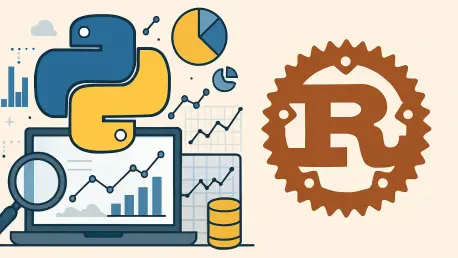In the ever-shifting landscape of programming languages, Python continues to stand out as a powerhouse, adapting to modern demands with remarkable agility and maintaining its position as a leader in innovation. Recent insights from the annual Python Developers Survey, conducted by the Python Software Foundation and JetBrains, reveal a community in transition, driven by an influx of new talent and groundbreaking technological integrations. With half of the developers having less than two years of professional experience, the Python ecosystem is witnessing a generational shift that influences learning methods and application focus. This transformation is not just about numbers; it reflects a deeper evolution in how Python is utilized, particularly in data science, and how it pairs with other languages like Rust to push performance boundaries. As the language matures, these trends signal a future where adaptability and innovation remain at the forefront, shaping the tools and practices of tomorrow’s developers.
Shifting Demographics and Learning Dynamics
The Python community is undergoing a notable demographic change, characterized by a significant number of newcomers reshaping engagement with the language. A striking 50 percent of developers possess under two years of professional programming experience, and 39 percent have similarly limited exposure to Python, even when factoring in personal projects. This wave of fresh talent is altering traditional learning pathways, with documentation still holding strong as a primary resource. However, a growing preference for visual and interactive content is evident, as 51 percent of younger developers turn to platforms like YouTube for education. Even more telling is the sharp rise in AI-driven learning tools, which have seen a 42 percent increase in adoption over the past year, climbing from 19 to 27 percent. This trend underscores a shift toward technology-enhanced learning, where accessibility and immediacy play crucial roles in skill acquisition for a generation eager to dive into coding with modern resources at their fingertips.
Beyond the influx of new developers, the implications of these learning shifts are profound for the broader Python ecosystem. The reliance on diverse educational tools suggests that the community must adapt to varied learning styles to maintain inclusivity and growth. As newer developers lean on video content and AI assistance, there’s an opportunity for more experienced members to contribute through tutorials and mentorship that cater to these preferences. This dynamic also raises questions about the depth of understanding achieved through quick, visual learning versus traditional, in-depth study. Ensuring that foundational knowledge isn’t sacrificed for speed will be critical as the community grows. Moreover, the rapid integration of AI tools hints at a future where such technologies could become standard in coding education, potentially streamlining onboarding processes but also necessitating guidelines to ensure accuracy and relevance in the learning materials provided.
Dominance in Data Science and AI Innovation
Python’s stronghold in data science and analytics has become more pronounced, now representing 51 percent of all projects utilizing the language. This shift marks a departure from its historically balanced application across web development and other domains, driven largely by the surge in AI and machine learning initiatives. Libraries such as Pandas and NumPy remain staples for data manipulation, while newer tools like Transformers and Diffusers are gaining ground in specialized AI applications. Additionally, emerging frameworks like Polars and Marimo are capturing attention for their efficiency in handling complex data processing tasks. This focus on data-centric applications positions Python as a leader in cutting-edge fields, where the ability to analyze and derive insights from vast datasets is increasingly vital. The language’s flexibility and extensive library support continue to make it a go-to choice for professionals tackling intricate analytical challenges.
The rise of data science within Python’s usage also reflects broader industry trends toward data-driven decision-making across sectors. As businesses and research institutions prioritize actionable insights, the demand for skilled developers who can leverage Python’s capabilities in this area continues to grow. This trend is further amplified by the language’s accessibility, allowing even those with minimal coding experience to contribute to data projects through user-friendly tools and libraries. However, this dominance raises the stakes for maintaining Python’s relevance in other areas like web development, where competition from other languages persists. Balancing its identity as a data science leader with versatility across domains will be essential. The ongoing innovation in AI-focused libraries also suggests that Python will remain at the forefront of technological advancements, provided the community continues to support and expand these resources for emerging needs.
Performance Boost through Rust Collaboration
A compelling trend in Python’s evolution is its growing integration with Rust, a language known for its speed and memory efficiency, to address performance limitations. Approximately one-third of Python developers now incorporate Rust to build binary modules, a rise from 27 percent in the prior survey. This collaboration shines in projects like Polars for data processing, Pydantic for data validation, and Granian as an application server, where Rust’s capabilities enhance Python’s simplicity without compromising its ease of use. A significant portion of new native code on the Python Package Index also leverages Rust, signaling a consensus on its value as a complementary tool. This partnership enables developers to achieve substantial performance gains, making Python more viable for high-demand applications where speed and resource efficiency are paramount.
The synergy between Python and Rust also highlights a pragmatic approach to overcoming inherent constraints in Python’s design, particularly around execution speed. For developers working on large-scale systems or real-time applications, this integration offers a way to maintain Python’s developer-friendly syntax while tapping into Rust’s robust performance features. Yet, this trend also points to a broader challenge: ensuring that such integrations are accessible to less experienced developers who may lack familiarity with Rust’s steeper learning curve. Community efforts to provide clear documentation and tutorials on combining these languages could bridge this gap. As more projects adopt this hybrid model, the potential for Python to expand into performance-critical domains grows, reinforcing its adaptability. This collaboration could redefine how developers approach building efficient, scalable solutions in the evolving tech landscape.
Challenges in Adopting Performance Updates
Despite Python’s forward momentum, a significant hurdle remains in the slow adoption of performance-enhancing updates. An alarming 83 percent of developers are using outdated versions of Python, forgoing notable improvements in speed and efficiency. For instance, upgrading from Python 3.10 to 3.13 can deliver a 42 percent boost in execution speed and a 20-30 percent reduction in memory usage. For businesses, this lag translates into substantial financial losses, with medium-sized companies potentially missing out on $420,000 in annual cloud cost savings and large enterprises up to $5.6 million. The reluctance to update often stems from satisfaction with current versions, cited by 53 percent of developers, and a lack of time for upgrades, noted by 25 percent. This resistance highlights a critical need for increased awareness and resources to ease the transition to newer versions.
Addressing this update lag requires a multifaceted approach that goes beyond simply promoting the benefits of newer Python releases. The community and industry stakeholders must prioritize creating tools and frameworks that simplify the migration process, especially for projects with complex dependencies. Educational campaigns could play a role in dispelling myths about the difficulty of updating, while showcasing real-world examples of cost and performance benefits. Additionally, the reasons behind developer hesitation—such as time constraints—suggest that organizational support, including dedicated time for technical upgrades, is essential. Without concerted efforts to bridge this adoption gap, the full potential of Python’s advancements remains untapped. As the language continues to evolve, ensuring that its user base keeps pace with available improvements will be crucial to maintaining its competitive edge in a fast-moving tech environment.
Resurgence in Diverse Applications
Python’s versatility shines through in its expanding use across various domains beyond data science, notably in web development and database management. Web development with Python has seen a resurgence, rising from 42 percent to 46 percent over the past year, with frameworks like FastAPI gaining significant traction. Its market share surged from 29 to 38 percent, reflecting a preference among newer developers for modern, lightweight tools over established ones like Django or Flask. Simultaneously, PostgreSQL has cemented its status as the preferred database among Python developers, with usage climbing from 43 to 49 percent. This open-source database remains relevant through continuous innovation, supporting Python’s adaptability in handling diverse data needs. These trends illustrate the language’s enduring appeal across multiple applications, reinforcing its role as a multifaceted tool in the developer’s toolkit.
The growth in web development and database usage also signals Python’s ability to evolve with industry demands while retaining a broad user base. FastAPI’s rise suggests a shift toward frameworks that prioritize speed and simplicity, catering to developers building scalable, API-driven applications in a cloud-centric world. Meanwhile, PostgreSQL’s sustained popularity underscores the importance of reliable, open-source solutions in managing data for Python projects. However, maintaining this diversity in application requires ongoing community support for tools and libraries across domains. As Python continues to dominate in data science, ensuring that resources and attention are also directed toward web and database applications will be vital. This balance prevents the language from becoming overly specialized, preserving its reputation as a general-purpose solution capable of meeting a wide array of technological challenges.
Reflecting on a Maturing Ecosystem
Looking back, the journey of Python reveals a landscape marked by dynamic shifts and persistent challenges that have shaped its trajectory. The influx of new developers brought fresh perspectives, driving innovative learning methods while emphasizing data science as a primary domain. Collaborations with Rust showcased a strategic push toward performance optimization, addressing long-standing limitations with impressive results. Yet, the slow uptake of critical updates stands as a reminder of the gaps between technological advancements and practical adoption. Growth in web development and database usage further highlights Python’s versatility, a testament to its adaptability across fields. Moving forward, the focus should center on bridging update barriers through accessible tools and education, ensuring that the community fully leverages Python’s capabilities. Encouraging balanced development across applications will solidify its standing, paving the way for sustained relevance in an ever-evolving tech world.









